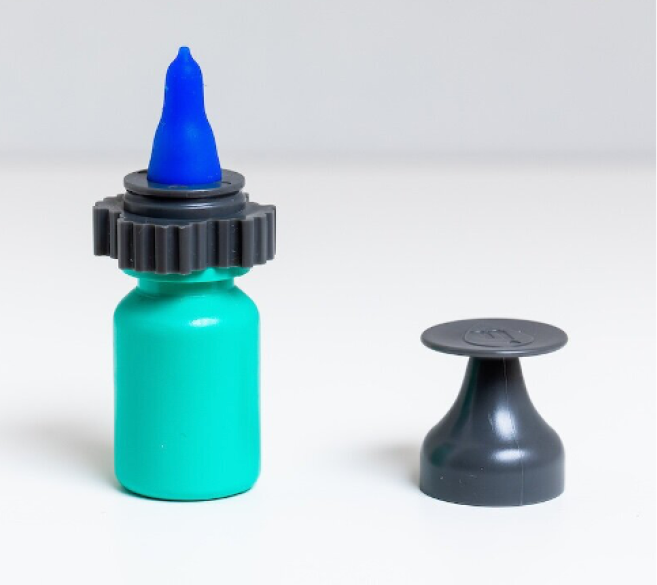1. TELL US ABOUT YOUR BACKGROUND AND CURRENT POSITION.
I am the CEO of Nanodropper and a third-year MD candidate at Mayo Clinic Alix School of Medicine. I consider myself an entrepreneur and inventor with a background in clean tech, neuroscience, and harm reduction. Since its founding in 2018, Nanodropper has won dozens of business and design awards, including a Collegiate Inventor medal, awarded by the National Inventors Hall of Fame of the US Patent and Trademark Office. Most recently, my cofounders and I were named honorees of the Forbes 30 Under 30 list in health care for 2021.
I’m a first-generation immigrant from South Korea. I graduated from the University of Washington in Seattle with a dual degree in psychology and biology. In addition to my interest in value-based innovations in health care, I conduct clinical research as a medical student through the departments of ophthalmology and plastic surgery at Mayo Clinic Rochester.
2. WHAT WAS THE UNMET NEED THAT PROMPTED YOU TO DEVELOP A SOLUTION?
In 2017, I read an NPR article that was featured in ProPublica titled “Drug Companies Make Eyedrops Too Big, and You Pay for the Waste.” It opened my eyes to the huge opportunity of bringing value to patients by simply reducing that waste. I then shared this problem with Elias Baker, who is now the chief operating officer of Nanodropper. We began to envision a patient-centered solution to this problem: a novel eye drop bottle adapter.
The article detailed how current eye drop bottles dispense about five times the amount of liquid an eye can absorb. For people who rely on prescription eye drops to treat their glaucoma or other eye diseases, this is a huge amount of waste that the patient ultimately pays for.
Although there are ongoing efforts to address the issue of waste in the health care system through reforms, expanded Medicare coverage, etc., there didn’t seem to be an immediate solution that gave power back to the patient. Existing efforts seemed to rely on legislation’s being passed or stakeholders’ championing an issue. In contrast, our adapter hands the solution directly to the patient.
3. DESCRIBE NANODROPPER AS IT STANDS TODAY.
The Nanodropper is an affordable, FDA-listed adapter for eye drop bottles that makes each drop about one-third the size of a standard drop (Figure). Smaller drops reduce the waste and cost of topical treatments, improving patient adherence, and the literature has demonstrated that smaller drops reduce side effects but provide equivalent efficacy. Our adapter unlocks all of these potential benefits.

Figure | The Nanodropper eye drop bottle adapter reduces droplet size to minimize waste and side effects.
After several pandemic-related production delays, we launched the product in June 2020. Since then, we have secured a number of partnerships to spread awareness of our device, including a relationship with the Department of Defense through a US Air Force Small Business Innovation Research contract.
We have now filled hundreds of orders across the country for patients and clinics alike. Patients can order the Nanodropper on our website or in person at one of our partner clinics in 16 states and Washington DC, with many more on the way.
The benefits of using the Nanodropper are fourfold:
- It reduces waste by creating smaller drops (Video 1). Decades of research support the efficacy of microdrops versus regular oversized drops. We are working with one of the leaders in this space, Alan L. Robin, MD, who is passionate about reducing the amount of medication wasted.
- Smaller drops extend bottle life by producing more doses per bottle. Patients frequently miss their eye when instilling eye drops, meaning that they can run out of vision-saving medications before insurance will cover the cost of the next bottle. With more drops to spare, patients face fewer barriers to adhering to their treatment plans. Less frequent refills also mean fewer trips to the pharmacy, reducing costs associated with transportation and, most important at present, reducing potential exposure to SARS-CoV-2.
- Nanodropper adapters save patients and clinics money. Patients pay less per drop and therefore potentially gain access to more expensive medications. Clinics can use the Nanodropper for administering in-clinic eye drops, such as those used for pupillary dilation, thereby reducing waste and cost.
- Smaller drops have been shown to reduce local and systemic side effects, factors that can have amplified effects on the health care system to deliver a higher value of care.
4. WHAT WERE THE MAJOR LESSONS LEARNED IN CONCEPTUALIZING YOUR IDEA?
One big lesson we quickly learned was the value of listening to patients. We interviewed a lot of patients to make sure we understood the problem we were hoping to solve and to identify any other pain points of using eye drops that we might be able to address (Video 2). Integrating patients’ feedback at every stage is an underrated part of developing a product, especially as the industry continues to move toward patient-centered products. This process also helped us be sure that the Nanodropper would not add unforeseen burdens on patients.
These interviews informed our approach to customer service as well. We have developed a number of ongoing relationships with patients who love the Nanodropper and subsequently became champions of our device. The whole Nanodropper team values these relationships, and we continue to learn from our patients every day. In turn, often just being accessible to them and listening offers reassurance. Too often, people with diseases such as glaucoma face difficult financial choices regarding their eye health. It’s been rewarding for me to see that we have helped ease patients’ burdens and helped them to navigate complex issues with both our invention and our relationships.
5. WHO OR WHAT IS YOUR BIGGEST INSPIRATION?
Lisa Su, PhD, the CEO of Advanced Micro Devices, is a hugely inspirational figure for me. For starters, she is one of the few female Asian-American CEOs running a Fortune 500 company. What I think sets Dr. Su apart from other CEOs is her intimate knowledge of the product her company offers. She’s not just another businessperson taking on the role of CEO. She’s an expert in her field with a PhD in electrical engineering; she understands the technological advantages Advanced Micro Devices has over its competitors, and she’s able to set company goals to leverage those core competencies. It’s been incredible to witness how she transformed the company in just a few years by combining her technical background with an equally strong vision.
Dr. Su inspires me with her approach to the job—she has stayed true to her goals for the company even during the difficult early years of her tenure. Returning the company to research and development and refocusing its energy were viewed as a risky proposition when all signs pointed to following the industry trends of the day. She trusted her instincts and the company’s already formidable abilities to become the best in its field. I think she showed the world that you can bet big and successfully disrupt an industry if you have a deep understanding of the DNA of your company. This, along with her dedication to delivering the very best products for her customers, is something that I hope I can emulate as I continue my journey in entrepreneurship.
6. WHAT WAS YOUR BIGGEST CHALLENGE EARLY IN YOUR PROJECT?
Different industries are primed for innovation to varying degrees. Some, more than others, are built to celebrate and integrate new companies with a robust network of support firms to serve their small business needs. We quickly learned that the medical device industry is not the most fertile startup ground. If your company wasn’t a spin-off from a large corporation with a readymade supply chain infrastructure in place, it was difficult to find contract manufacturers optimized for small-volume production.
For our brand-new company, establishing those connections was one of the biggest challenges. After much struggle and lots of networking, we were able to find US manufacturers that took a leap of faith with us. We feel fortunate that we had great guidance and used a US manufacturer, because our launch would’ve been delayed further had we been working with an overseas manufacturer.
7. WHAT IS YOUR BIGGEST CHALLENGE CURRENTLY?
As we scale up, we are trying to spread the word about our device and increase adoption while keeping patients’ interests at the forefront. We don’t want to become yet another company that transfers additional cost burdens to patients. Practicing stewardship with our own costs means that our product will be more affordable, so our current challenge is to be mindful of this need for efficiency in our strategy and to find the right balance.
A big part of our marketing effort is creating educational materials for the public about eye health and the Nanodropper adapter. Health literacy is yet another barrier to proper care and treatment, so we try to structure our educational content in a way that is written for anyone, from the patient just diagnosed with glaucoma to the eye care professional who will quickly see the Nanodropper’s value proposition for patients. The team is learning quite a bit as we tackle various subjects.
8. HOW MANY PEOPLE ARE EMPLOYED BY NANODROPPER?
Nanodropper has seven employees.
9. WHAT’S NEXT FOR YOUR PROJECT?
Our team is working diligently to scale up operations. We’re getting the Nanodropper in front of more eye care professionals every day. Our goal is to establish a robust network of partner clinics that offer the Nanodropper to their patients and, we hope, even use it for in-clinic exams.
10. WHAT ADVICE CAN YOU OFFER TO OTHER PHYSICIANS OR PHYSICIANS-IN-TRAINING WHO ARE INTERESTED IN ENTREPRENEURSHIP?
I would encourage individuals with an entrepreneurial spirit to pursue their venture regardless of where they are in their training or professional life. Physicians are the leaders in clinical settings, so I see entrepreneurship as a natural progression for physicians to spearhead future changes in the health care system. There is a palpable push for more physician leadership in every part of the industry, and I think entrepreneurship is the perfect avenue for experts who see problems firsthand in their clinics to be forces for disruption to create a better system.
Our company was founded with the mission of setting a precedent for innovation that can deliver value-based care for patients. We are constantly finding like-minded physicians and small business owners who are aligned with that ethos of putting the needs of the patient first. I’d say find those like-minded people who will build you up and support you. It will make pursuing your dream infinitely easier to attain, and I think that’s the best advice I can pass on!




